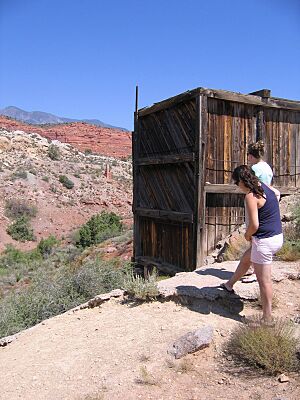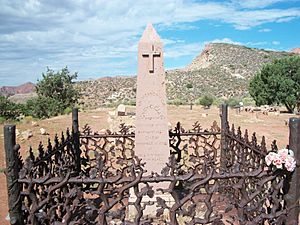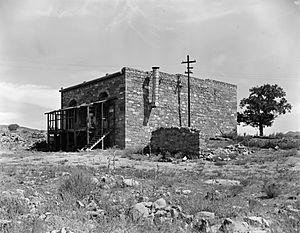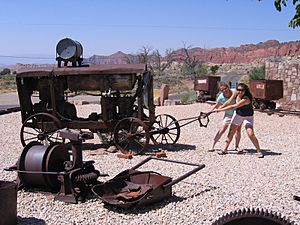Silver Reef, Utah facts for kids
Quick facts for kids
Silver Reef
|
|
|---|---|
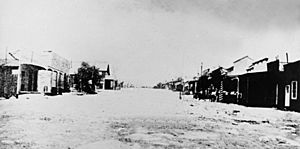
Silver Reef in the 1880s
|
|
| Country | United States |
| State | Utah |
| County | Washington |
| Founded | 1875 |
| Abandoned | 1891 |
| Named for | Silver in sandstone formations |
| Elevation | 3,796 ft (1,157 m) |
| GNIS feature ID | 1445602 = |
Silver Reef is a ghost town in Washington County, Utah, United States. It is about 15 miles (24 km) northeast of St. George and 1 mile (1.6 km) west of Leeds.
Silver Reef started because of a special discovery. In 1866, a prospector named John Kemple found silver in a sandstone rock formation. This was unusual because silver is not usually found in sandstone. In 1875, two bankers from Salt Lake City sent William Barbee to check it out. He claimed 21 mining spots. Many miners then came to work these spots and find their own.
To house the miners, Barbee created a town called Bonanza City. Land there was expensive. So, some miners settled on a ridge north of it. They called their new settlement Rockpile. Later, the town was renamed Silver Reef. This happened after silver mines in nearby Pioche closed. Many business people from Pioche moved to Silver Reef.
By 1879, about 2,000 people lived in Silver Reef. The town had a long Main Street with many shops. These included a Wells Fargo office and the Cosmopolitan Restaurant. Even though it was near many Mormon towns, Silver Reef only had a Catholic church. In 1879, a fire destroyed many businesses. But the people quickly rebuilt them. Mines slowly closed, mostly by 1884. This was because the price of silver around the world dropped. By 1901, most buildings were taken apart or moved to Leeds.
Mining started again in 1916 under Alex Colbath. His company was called Silver Reef Consolidated Mining. Later, American Smelting and Refining Company bought these mines in 1928. But they did little work because of the Great Depression. Western Gold & Uranium Corporation bought the mines in 1948. In 1951, they began mining uranium there. These operations also did not last long. The 5M Corporation bought the mines in 1979. Today, some old buildings like the Wells Fargo office and the Cosmopolitan Restaurant remain. A few homes have also been built in the area. Silver Reef is now part of the nearby community of Leeds.
Contents
Exploring Silver Reef's Geography
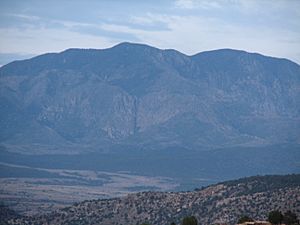
The special sandstone rocks that gave Silver Reef its name formed in a unique way. Earth's movements pushed long sections of Navajo Sandstone to stand on their sides. This made them look like ocean reefs. Over a long time, silver ore, dirt, and plants were carried by water. This water came from the Chinle Formation to the White, Buckeye, and East reefs. The silver settled as deposits. The plants turned into petrified wood.
The Silver Reef mining area mainly has silver. But it also has smaller amounts of copper, gold, lead, and uranium. The red color of the soil comes from Iron oxide deposits. You can even find dinosaur tracks from the early Jurassic period here!
Silver Reef is near the western edge of the Colorado Plateau. It is about 15 miles (24 km) northeast of St. George. It is also 1 mile (1.6 km) west of Leeds. To the west of Silver Reef, you'll find Dixie National Forest and the Pine Valley Mountain Wilderness. This wilderness area has different plants like sagebrush and pine trees. Interstate 15 is 1 mile (1.6 km) east of Silver Reef.
Silver Reef's Climate
Silver Reef is one of the driest and hottest places in Utah. Summer temperatures often go above 100°F (38°C). Winters are mild, with average temperatures around 50°F (10°C). But nighttime temperatures can sometimes drop below 0°F (-18°C). Silver Reef gets about 12 inches (30 cm) of rain each year. It can also get an inch or more of snow in winter.
July is the warmest month, with an average of 99°F (37°C). December is the coldest, averaging 53°F (12°C). The hottest temperature ever recorded was 114°F (46°C) in July 2001. The coldest was -2°F (-19°C) in January 1963.
| Climate data for Silver Reef, Utah | |||||||||||||
|---|---|---|---|---|---|---|---|---|---|---|---|---|---|
| Month | Jan | Feb | Mar | Apr | May | Jun | Jul | Aug | Sep | Oct | Nov | Dec | Year |
| Record high °F (°C) | 74 (23) |
80 (27) |
93 (34) |
97 (36) |
106 (41) |
111 (44) |
114 (46) |
111 (44) |
107 (42) |
97 (36) |
85 (29) |
74 (23) |
114 (46) |
| Mean daily maximum °F (°C) | 53 (12) |
60 (16) |
66 (19) |
75 (24) |
84 (29) |
94 (34) |
99 (37) |
97 (36) |
90 (32) |
78 (26) |
63 (17) |
54 (12) |
76 (25) |
| Mean daily minimum °F (°C) | 27 (−3) |
32 (0) |
38 (3) |
43 (6) |
51 (11) |
59 (15) |
65 (18) |
64 (18) |
56 (13) |
45 (7) |
33 (1) |
27 (−3) |
45 (7) |
| Record low °F (°C) | −2 (−19) |
2 (−17) |
10 (−12) |
21 (−6) |
23 (−5) |
34 (1) |
46 (8) |
39 (4) |
31 (−1) |
17 (−8) |
12 (−11) |
1 (−17) |
−2 (−19) |
| Average precipitation inches (mm) | 1.56 (40) |
1.59 (40) |
1.78 (45) |
0.78 (20) |
0.55 (14) |
0.28 (7.1) |
0.71 (18) |
1.10 (28) |
0.88 (22) |
0.94 (24) |
1.08 (27) |
0.77 (20) |
12.02 (305) |
| Source: weather.com | |||||||||||||
People of Silver Reef: A Look at Its Population
| Historical population | |||
|---|---|---|---|
| Census | Pop. | %± | |
| 1880 | 1,046 | — | |
| 1890 | 177 | −83.1% | |
| 1990 | 50 | — | |
| Source: Population History of Western U.S. Cities and Towns | |||
Silver Reef was first settled in 1875. By 1880, 1,046 people lived there. A local count in 1884 showed 1,500 residents. By 1890, after most mines closed, the population dropped to 177. By 1900, only a few people who rented the mines lived there.
In 1916, Alex Colbath started the Silver Reef Consolidated Mining Company. Some miners moved in to work for him. Colbath and his wife, Mayme, lived in the town until the 1950s. After they left, Silver Reef became completely empty. Land was divided up in the 1960s and finished by 1980. In 1990, 50 people lived in Silver Reef. Today, Silver Reef is considered part of Leeds.
Silver Reef's Rich History
The Silver Reef area was first home to Anasazi Native Americans. They lived there between about 200 AD and 1300 AD. The Anasazi were nomads, meaning they moved around. They followed animals like deer and sheep for hunting. They also grew crops like corn and wheat. Many were skilled potters. They built temporary homes from sticks and leaves. Sometimes, they made stronger homes from rocks on mountain sides. A group of Virgin Anasazi lived at the Red Cliffs Anasazi Site.
Silver was found in the area in the 1860s. One popular story says a prospector named John Kemple came from Montana in 1866. He stayed at Orson B. Adams' home in Harrisburg. Kemple found a silver vein near the home. He didn't find enough to stay, so he left for Nevada. Five years later, Kemple returned. He claimed some mining spots and started the Union Mining District. This district was later abandoned. But in 1874, Kemple came back with more miners. They restarted mining under the Harrisburg Mining District. Kemple later sold his claims.
Another story says a man named "Metalliferous" Murphy found the silver. He was an assayer from Pioche, Nevada. Miners from Pioche brought him a piece of sandstone. Murphy tested it and found a lot of silver. He learned the sandstone came from the Silver Reef area. Murphy never claimed land, but his discovery got miners interested.
At first, geologists and other miners did not believe silver was in sandstone. The Smithsonian Institution even called a sample an "interesting fake." In 1875, news of the silver reached the Walker brothers. They were famous bankers from Salt Lake City. They hired William T. Barbee to claim mines for them. Barbee claimed 21 spots. He wrote an article in The Salt Lake Tribune about the "rich silver mines." This started a silver rush. By late 1875, Barbee had started Bonanza City.
Business people came, making land prices very high. Many miners and business owners looked for cheaper land. They set up a tent city north of Bonanza City. They called it "Rockpile." In November 1875, mines in nearby Pioche closed. Many miners and owners from Pioche moved to "Rockpile." This was called the "Pioche Silver Stampede." The settlement's name changed to Silver Reef. When the St. George LDS Temple finished in 1877, workers found jobs in Silver Reef. Lumber for buildings came from Pine Valley Mills. At first, Silver Reef had no smelter. Silver ore was sent to Pioche and Salt Lake City to be processed.
After the silver rush, the town was planned and built. The first permanent shop was a store where roads from three reefs met. By 1878, the town had a hotel, boarding houses, nine stores, six saloons, five restaurants, a bank, and two dance halls. It also had a newspaper called The Silver Echo. Two cemeteries were south of the business area. Most businesses were on a mile-long Main Street. The mining area had 37 mines and five stamp mills.
Even though it was surrounded by Mormon towns, Silver Reef never had a Mormon church. Only a Catholic church was in town. After the First Transcontinental Railroad finished in 1869, many Chinese workers lost their jobs. About 250 of them created a Chinatown just south of Silver Reef. This Chinatown had its own Chinese mayor and businesses. By 1879, Silver Reef's population was 2,000. The town also had a horse race track, a brewery, and a brass band.
Most Silver Reef residents were not Mormon. But they got along well with people from nearby Mormon towns. Many farm goods were brought to Silver Reef by wagon. Mormon workers helped build many of the town's buildings. A Catholic priest, Reverend Lawrence Scanlan, even gave Mass in the St. George Tabernacle. The Mormon choir learned Latin songs to help him.
However, politics sometimes caused problems. Most Mormons were in the People's Party. Most Silver Reef residents were in the Liberal Party. As Silver Reef grew, people wanted it to be the main town of Washington County. This worried the People's Party leaders. In 1882, the state government moved the county line. This kept the People's Party in charge of Washington County.
Silver Reef had some disagreements between miners and mine owners.
The Decline of Silver Reef
On May 30, 1879, a fire started under a restaurant. People tried to put it out with water from Leeds Creek. They also put wet blankets on nearby buildings. But the fire spread to the Harrison House Hotel, a big building. The fire destroyed several businesses on Main Street. The Salt Lake Tribune reported that Silver Reef had been "Chicagoed." This meant it was badly burned, like Chicago.
Silver Reef's residents rebuilt the businesses. But the town soon began to shrink. In 1881, two mining companies lowered wages for miners. They went from $4 a day to $3.50 a day. In response, the Silver Reef Miners Union was formed. Union members talked about striking. The mining company fired union members. The fired members then made the company's boss, Washington Allen, leave Silver Reef.
Allen went to court and sued the union members. Before court, the union decided to shut down a mine called Savage. Led by Matthew O'Loughlin, the union president, they marched through town. At the mine, O'Loughlin and nine others told the engineer to turn off the pumps. These pumps kept water out of the mine. After the pumps stopped, they told everyone to leave the mine.
A few days later, the sheriff arrested 25 union members. Silver Reef's jail was too small. Most were held in the Rice Building. A line was drawn around the building. Anyone who crossed it was threatened. The union members were sent to Beaver for trial. They were charged with riot and other crimes. Thirteen members were sent to prison. Matthew O'Loughlin got 20 days in prison and a $75 fine.
A few years after the strike, the price of silver dropped worldwide. Many mines had to close. To deal with lower prices, mine owners cut miners' wages again. This time, the miners accepted it. Also, miners dug too deep. Water filled the mine shafts faster than it could be pumped out. By 1884, most mines were closed. The last one officially closed in 1891. But some people kept mining small amounts.
Many shop owners went out of business and left town. The Silver Reef mines produced about $8 million worth of silver. Between 1891 and 1901, another $250,000 was mined. Several people tried to restart mining in later years, but none worked. After the mines closed, many buildings were bought for their wood and stone. One buyer found $10,000 in gold coins when taking apart a building. News spread, and most buildings were torn down hoping to find more gold. But no more was found.
The Silver Reef Consolidated Mining Company started in 1916. Alex Colbath owned most of the mines. In 1928, American Smelting and Refining Company bought his mines. They dug a new shaft in 1929. This shaft connected to the flooded Savage mine, and the water was pumped out. But little work was done after that. There wasn't enough silver to make a profit during the Great Depression.
Ownership went back to Alex Colbath. But in 1948, Western Gold and Uranium Corporation bought the mines from him. In 1951, they mined the sandstone for uranium. The first uranium came from the Ann's Pride mine. In total, 2,500 pounds (1,100 kg) of uranium were shipped out. The 5M Corporation bought the mines in 1979. But they did not operate in Silver Reef for long.
Visiting Silver Reef: History and Fun
After the mines closed, the Wells Fargo office became a home. Alex and Mayme Colbath lived there until the 1950s. It was added to the National Register of Historic Places in 1971. Today, it is an art gallery and museum. The Rice Building burned down but was rebuilt in 1991. The Cosmopolitan Restaurant was rebuilt to look like it did in the 1800s. It served European food until 2010.
Many old house foundations and walls remain. Markers show where buildings like the Elk Horn Saloon once stood. Some areas are protected for their history.
Behind the Wells Fargo office is a powder house. In 2011, it held models of the town, its mills, and the Catholic church. The Catholic and Protestant cemeteries were fixed up in 1998. You can visit them. Other original buildings still stand. These include the Clancy Market and the Harrison House Hotel. Main Street, once a mile long, is now only a few hundred yards. It is surrounded by private homes.
Besides exploring the ghost town, visitors can enjoy the red rock country around Silver Reef. You can go backpacking, camping, fishing, mountain biking, birdwatching, and hunting. At Red Cliffs Recreation Area, south of Silver Reef, you can picnic among cottonwood trees. A short hiking trail leads to the Red Cliffs Anasazi Site. This site has remains of an Anasazi home. The 6-mile (9.7 km) Red Reef Trail leads to the Cottonwood Wilderness Study Area. You can find dinosaur footprints from the early Jurassic period here. The Orson Adams House in nearby Harrisburg teaches about the pioneer history of Washington County.
Silver Reef has been in American films since the late 1960s. It was a filming location for Butch Cassidy and the Sundance Kid (1969). It was also a background in The Electric Horseman (1979). Silver Reef was shown in the 1998 documentary Treasure House: The Utah Mining Story.
In 2018, the book Five Nights At Freddy's: The Fourth Closet by Scott Cawthon featured Silver Reef, Utah. In the book, the town was where a character named Charlotte Emily's aunt Jen lived alone.





